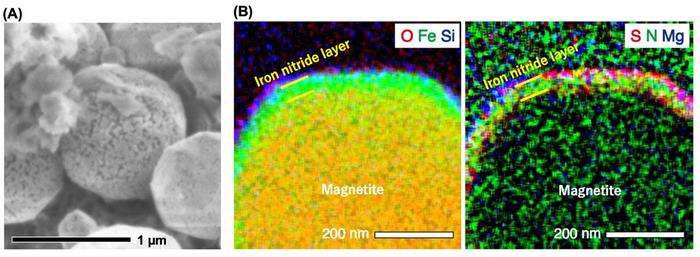Micrometeorites originating from icy celestial bodies in the outer Solar System may be responsible for transporting nitrogen to the near-Earth region in the early days of our solar system. That discovery was published today in Nature Astronomy by an international team of researchers, including University of Hawai’i at Mānoa scientists, led by Kyoto University.

Credit: KyotoU/Toru Matsumoto
Micrometeorites originating from icy celestial bodies in the outer Solar System may be responsible for transporting nitrogen to the near-Earth region in the early days of our solar system. That discovery was published today in Nature Astronomy by an international team of researchers, including University of Hawai’i at Mānoa scientists, led by Kyoto University.
Nitrogen compounds, such as ammonium salts, are abundant in material born in regions far from the sun, but evidence of their transport to Earth’s orbital region had been poorly understood.
“Our recent findings suggests the possibility that a greater amount of nitrogen compounds than previously recognized was transported near Earth, potentially serving as building blocks for life on our planet,” says Hope Ishii, study co-author and affiliate faculty at the Hawai’i Institute of Geophysics and Planetology in the UH Mānoa School of Ocean and Earth Science and Technology (SOEST).
Like all asteroids, Ryugu is a small, rocky object that orbits the sun. The Japan Aerospace Exploration Agency’s Hayabusa2 spacecraft explored Ryugu and brought material from its surface back to Earth in 2020. This intriguing asteroid is rich in carbon and has undergone significant space weathering caused by micrometeorite collisions and exposure to charged ions streaming from the sun.
In this study, the scientists aimed to discover clues about the materials arriving near Earth’s orbit, where Ryugu is currently located, by examining the evidence of space weathering in Ryugu samples. Using an electron microscope, they found that the surface of the Ryugu samples are covered with tiny minerals composed of iron and nitrogen (iron nitride: Fe4N).
“We proposed that tiny meteorites, called micrometeorites, containing ammonia compounds were delivered from icy celestial bodies and collided with Ryugu,” said Toru Matsumoto, lead author of the study and assistant professor at Kyoto University. “The micrometeorite collisions trigger chemical reactions on magnetite and lead to the formation of the iron nitride.”
The iron nitride was observed on the surface of magnetite, which consists of iron and oxygen atoms. When magnetite is exposed to the space environment, oxygen atoms are lost from the surface by the irradiation of hydrogen ions from the sun (solar wind) and by heating through micrometeorite impact. These processes form metallic iron on the very surface of the magnetite, which readily reacts with ammonia, creating ideal conditions for synthesis of iron nitride.
###
The paper “Influx of nitrogen-rich material from the outer Solar System indicated by iron nitride in Ryugu samples” appeared on 30 November 2023 in Nature Astronomy, with doi: 10.1038/s41550-023-02137-z
About Kyoto University
Kyoto University is one of Japan and Asia’s premier research institutions, founded in 1897 and responsible for producing numerous Nobel laureates and winners of other prestigious international prizes. A broad curriculum across the arts and sciences at undergraduate and graduate levels complements several research centers, facilities, and offices around Japan and the world. For more information, please see: http://www.kyoto-u.ac.jp/en
About the School of Ocean and Earth Science and Technology
SOEST at the University of Hawai’i at Mānoa was established by the Board of Regents of the University of Hawai’i in 1988 in recognition of the need to realign and further strengthen the excellent education and research resources available within the University. SOEST brings together academic departments, multiple research institutes, several federal cooperative programs, and support facilities of the highest quality in the nation to meet pressing challenges in the ocean, earth, and planetary sciences and society.
Journal
Nature Astronomy
DOI
10.1038/s41550-023-02137-z
Method of Research
Experimental study
Subject of Research
Not applicable
Article Title
Influx of nitrogen-rich material from the outer Solar System indicated by iron nitride in Ryugu samples
Article Publication Date
30-Nov-2023
COI Statement
The authors declare no competing interests.




